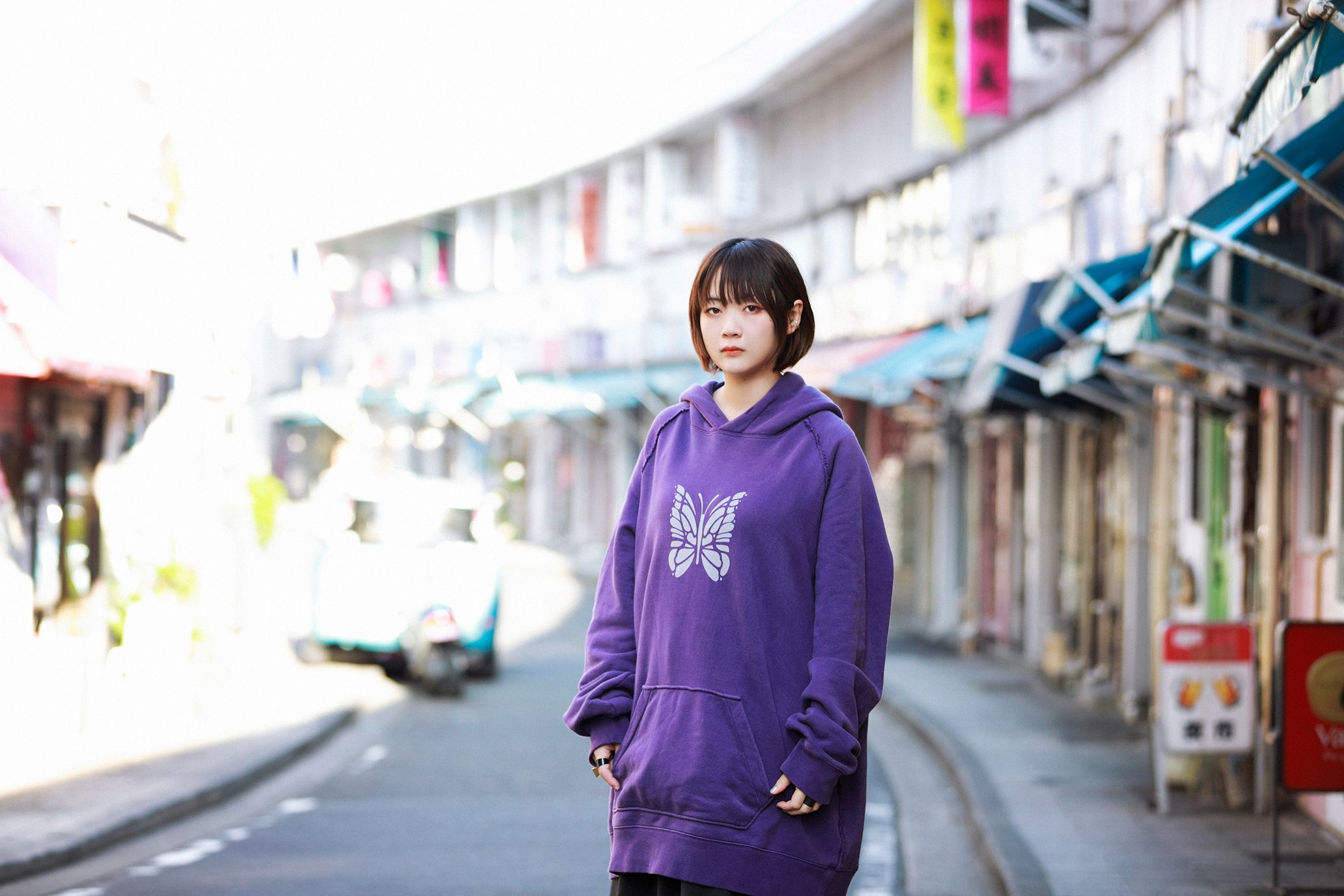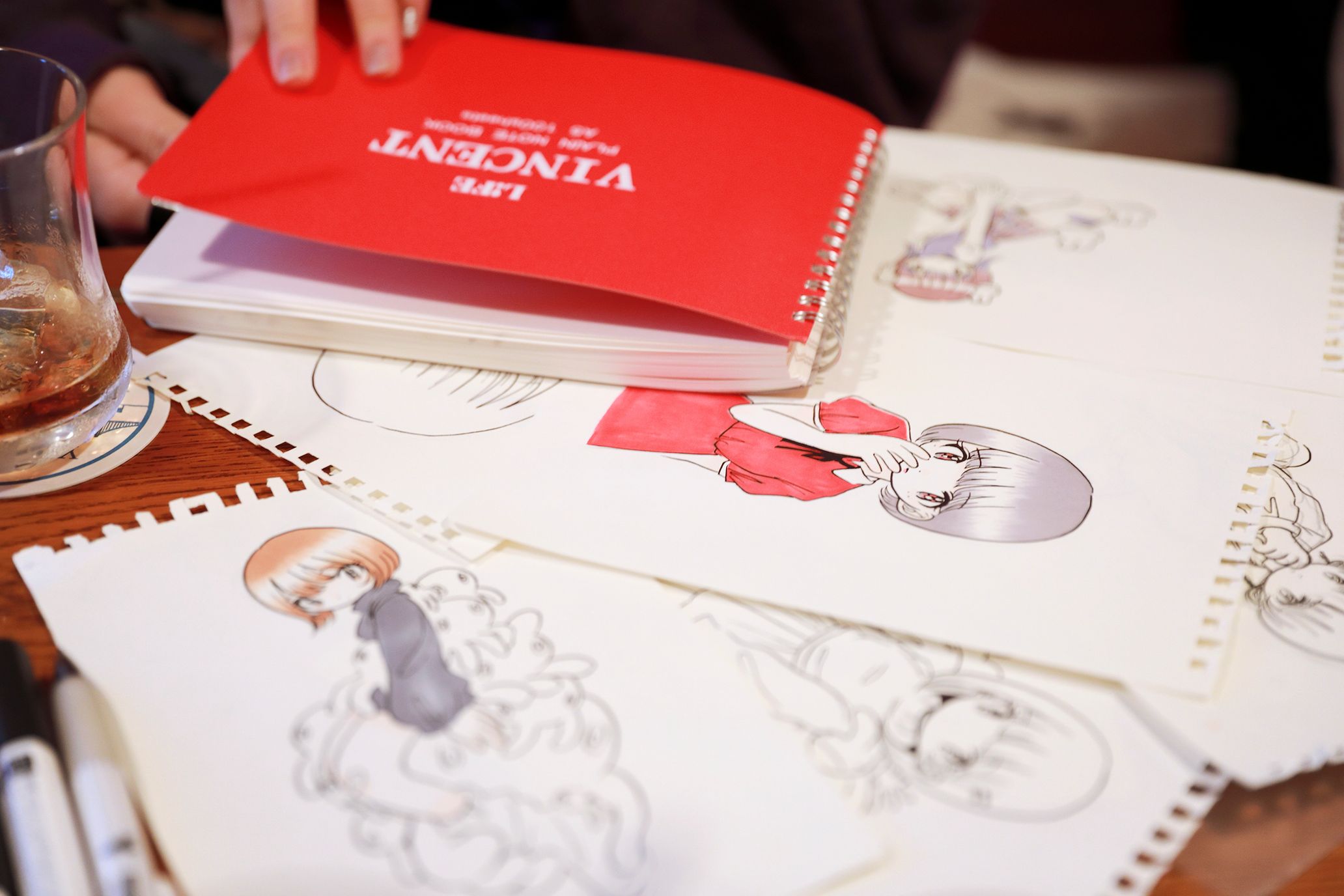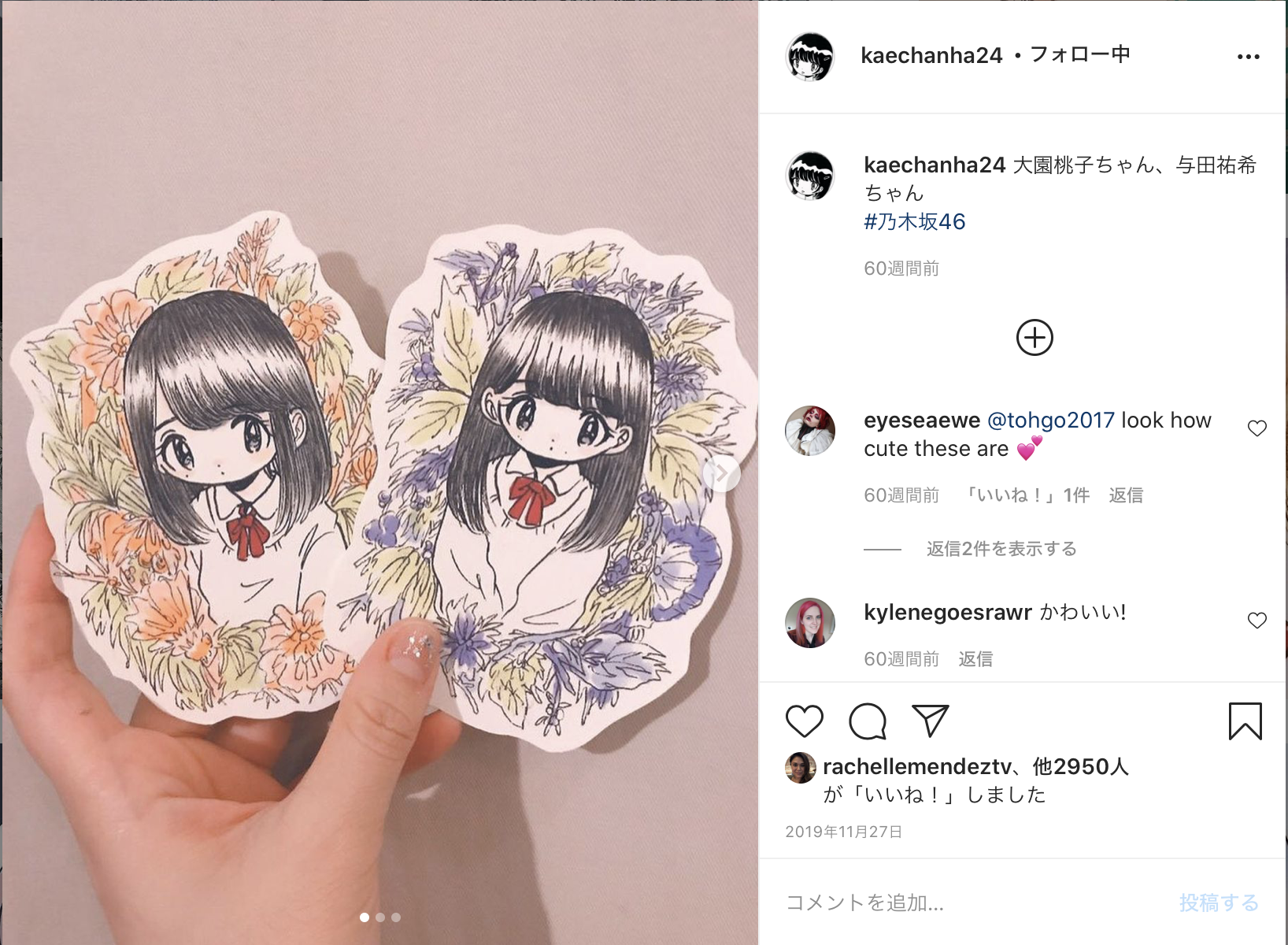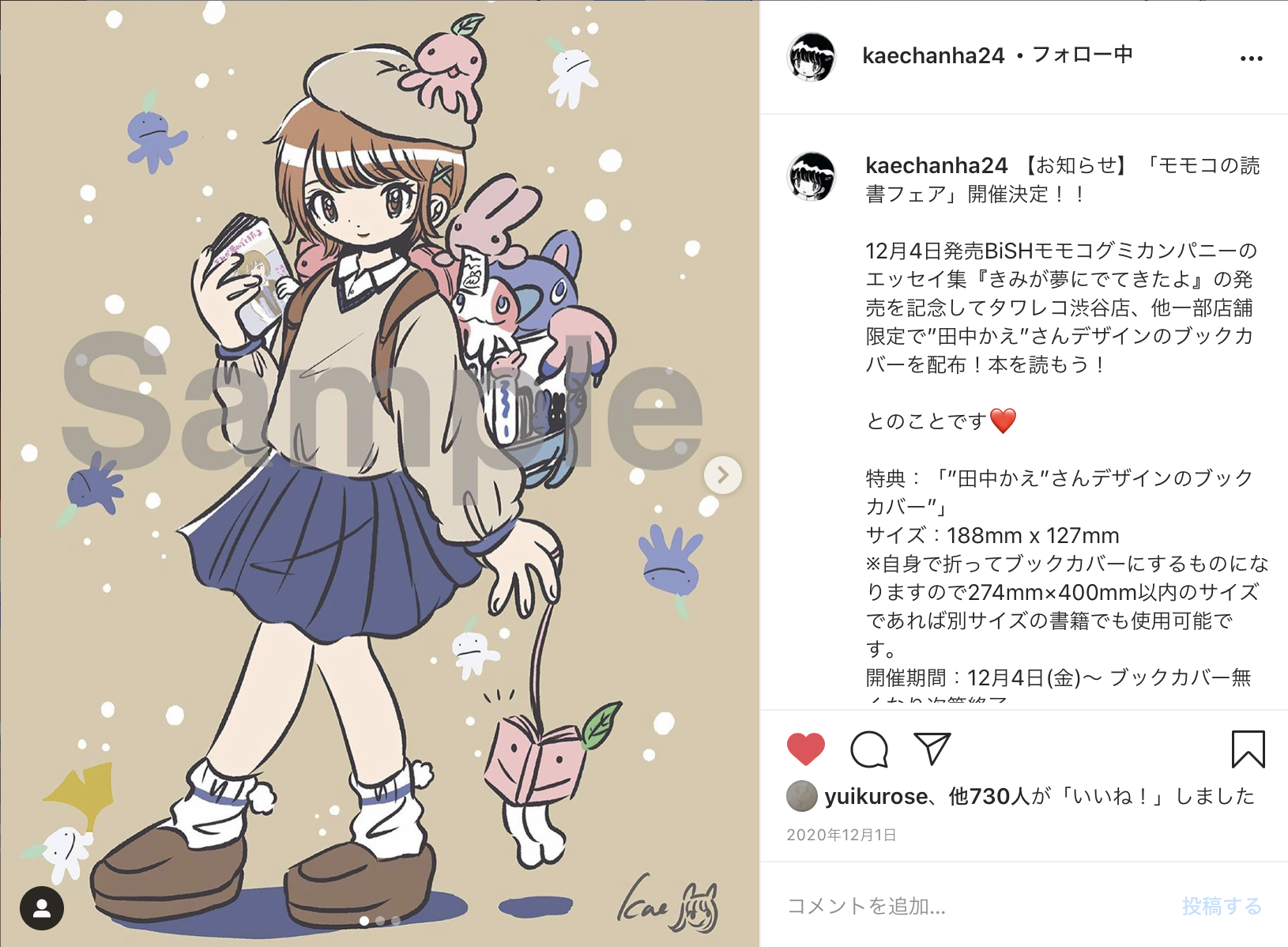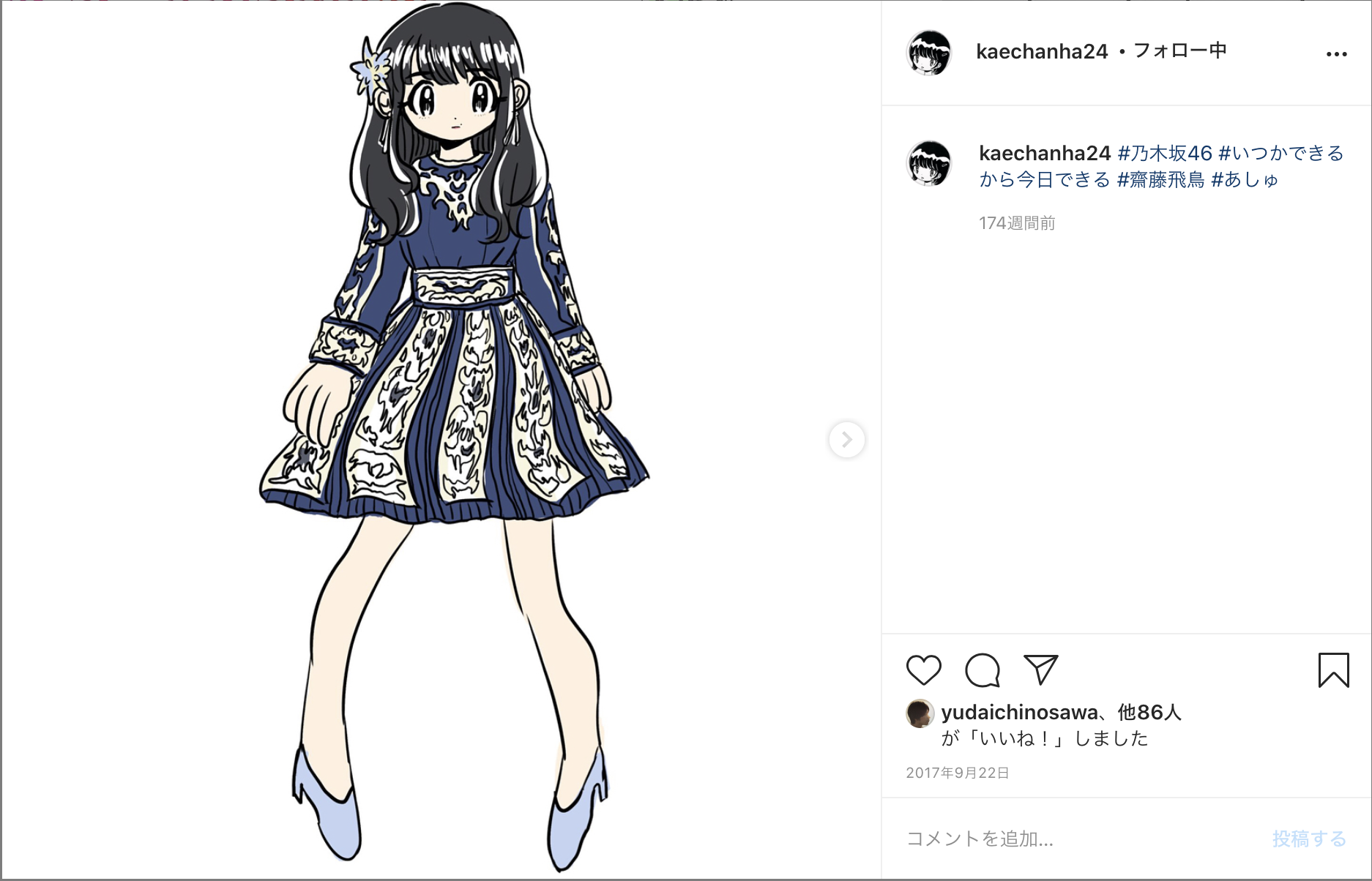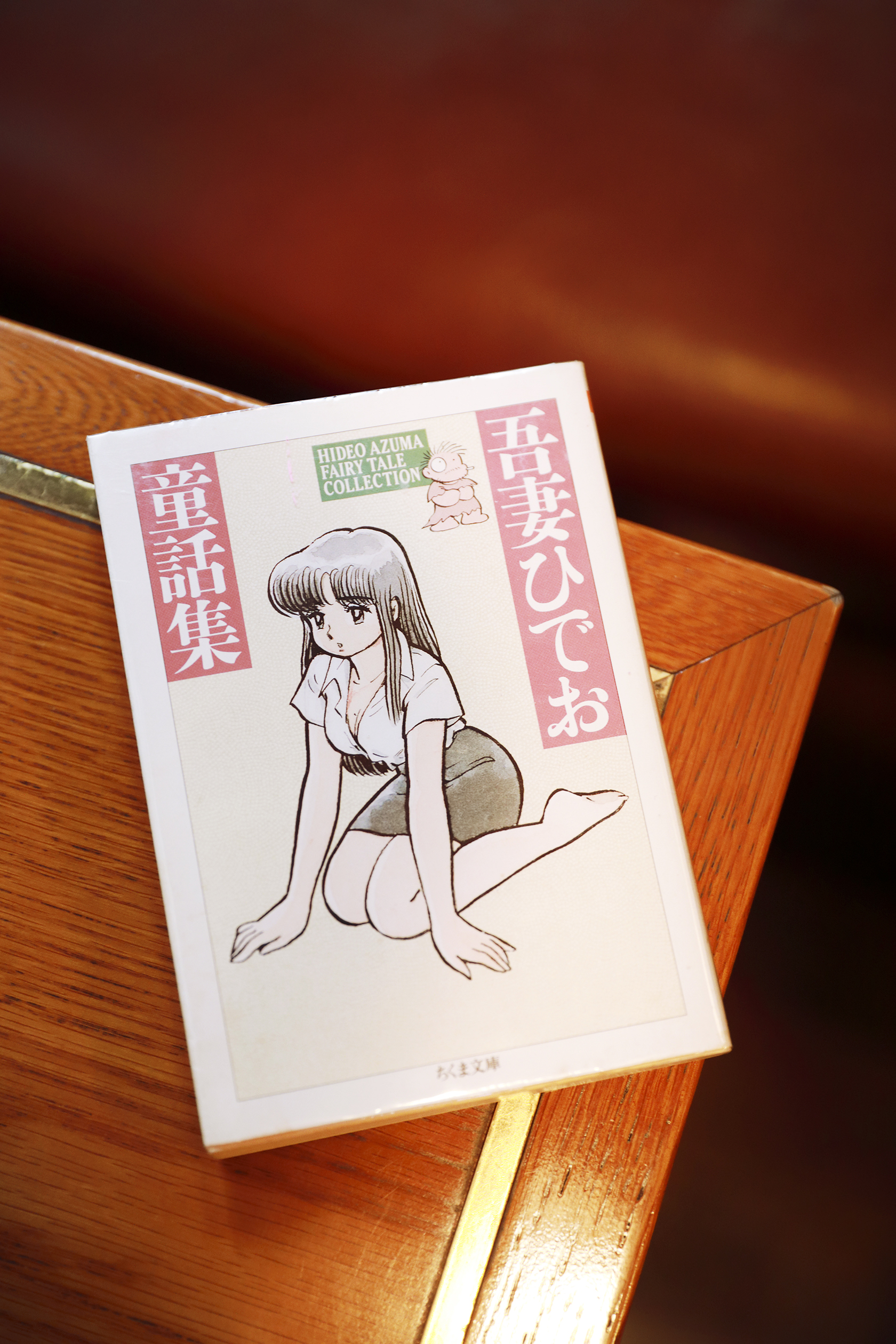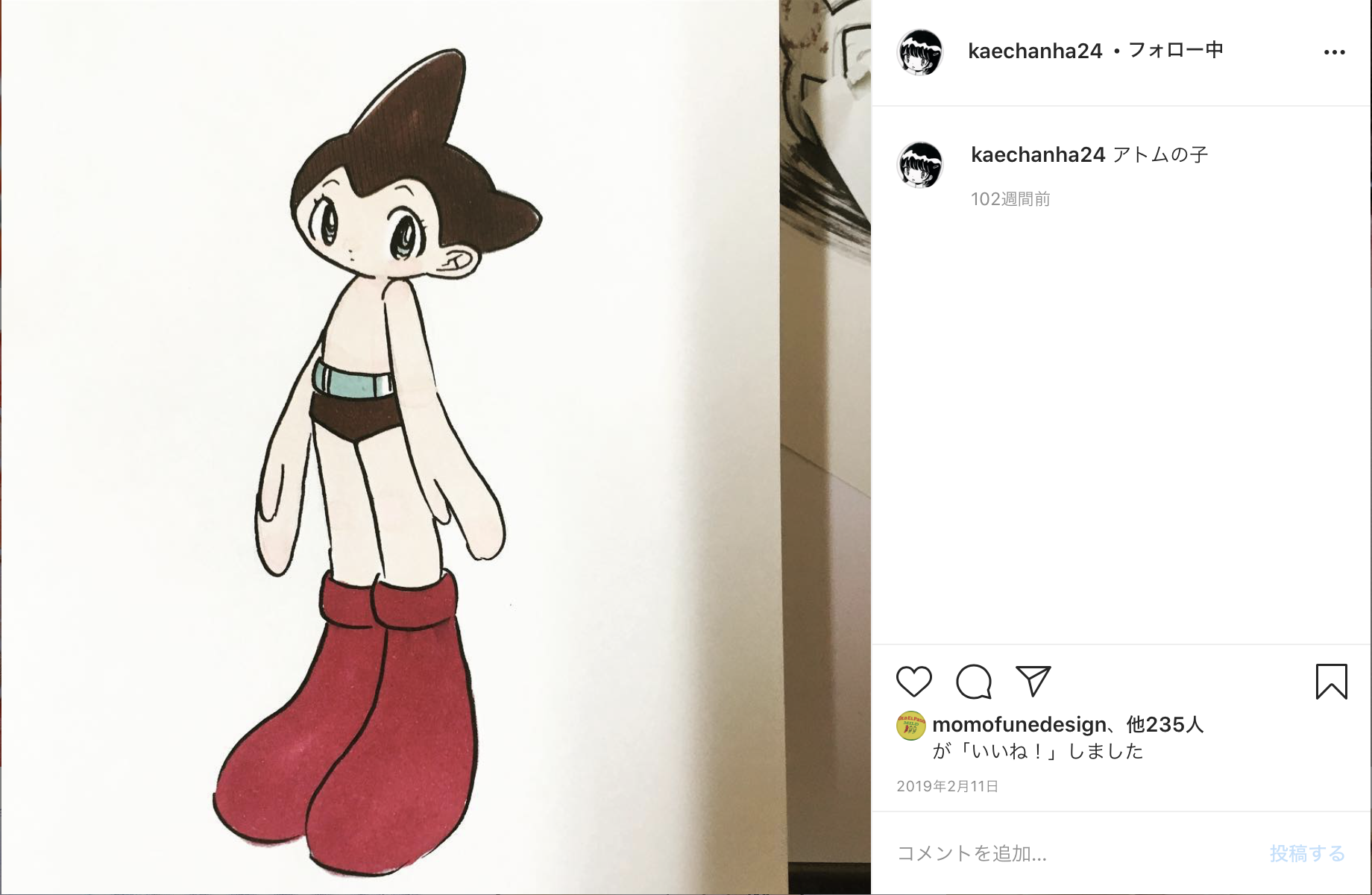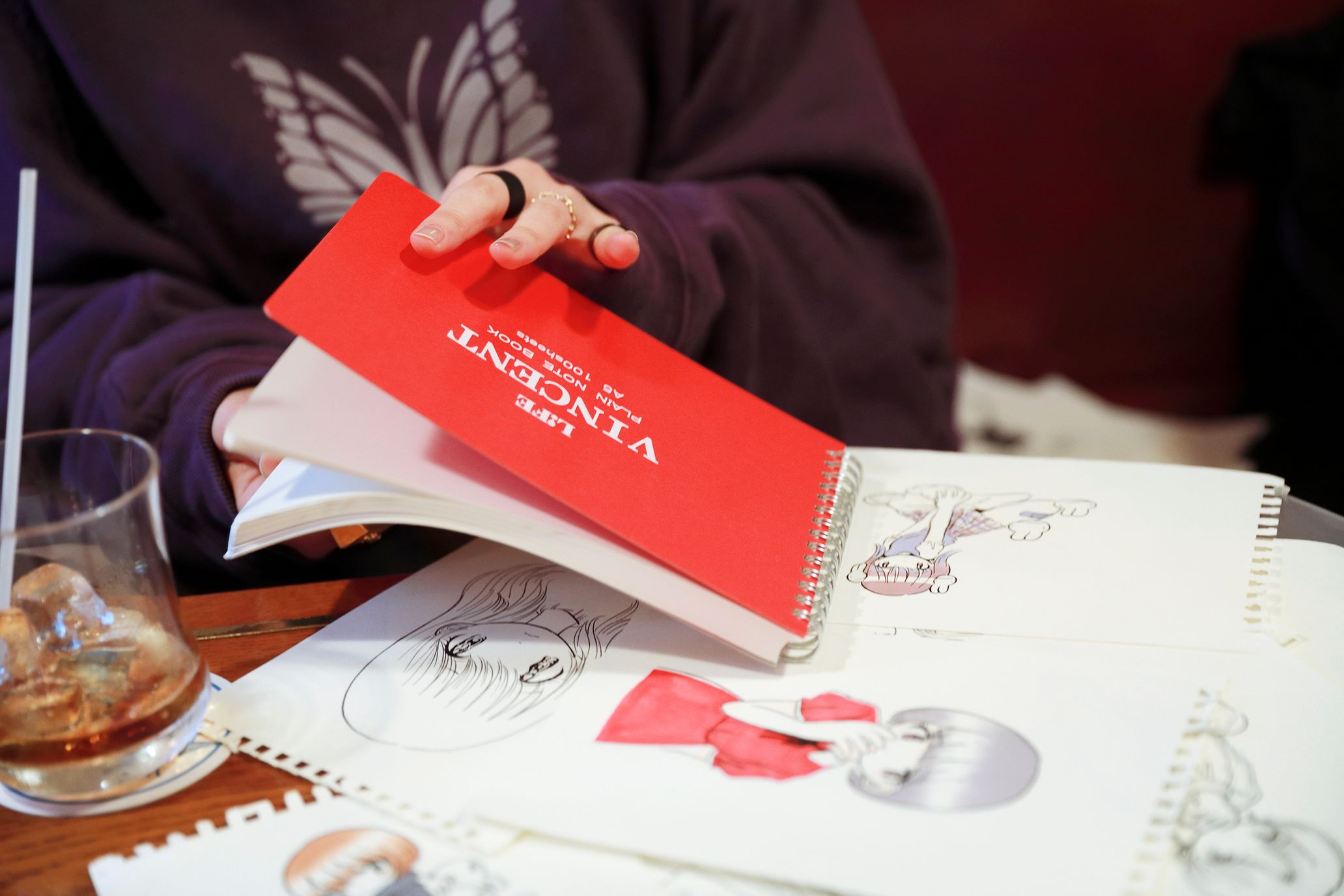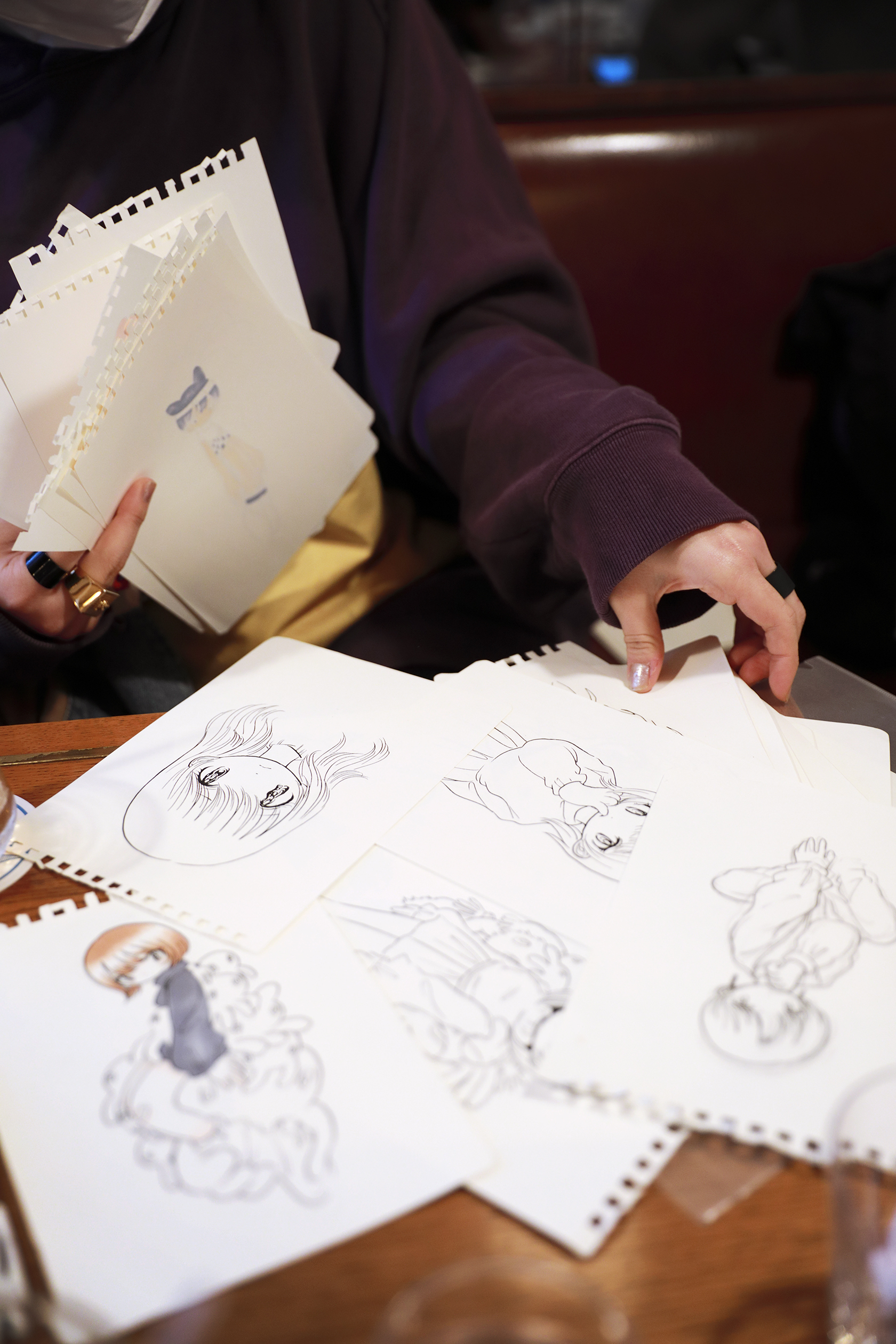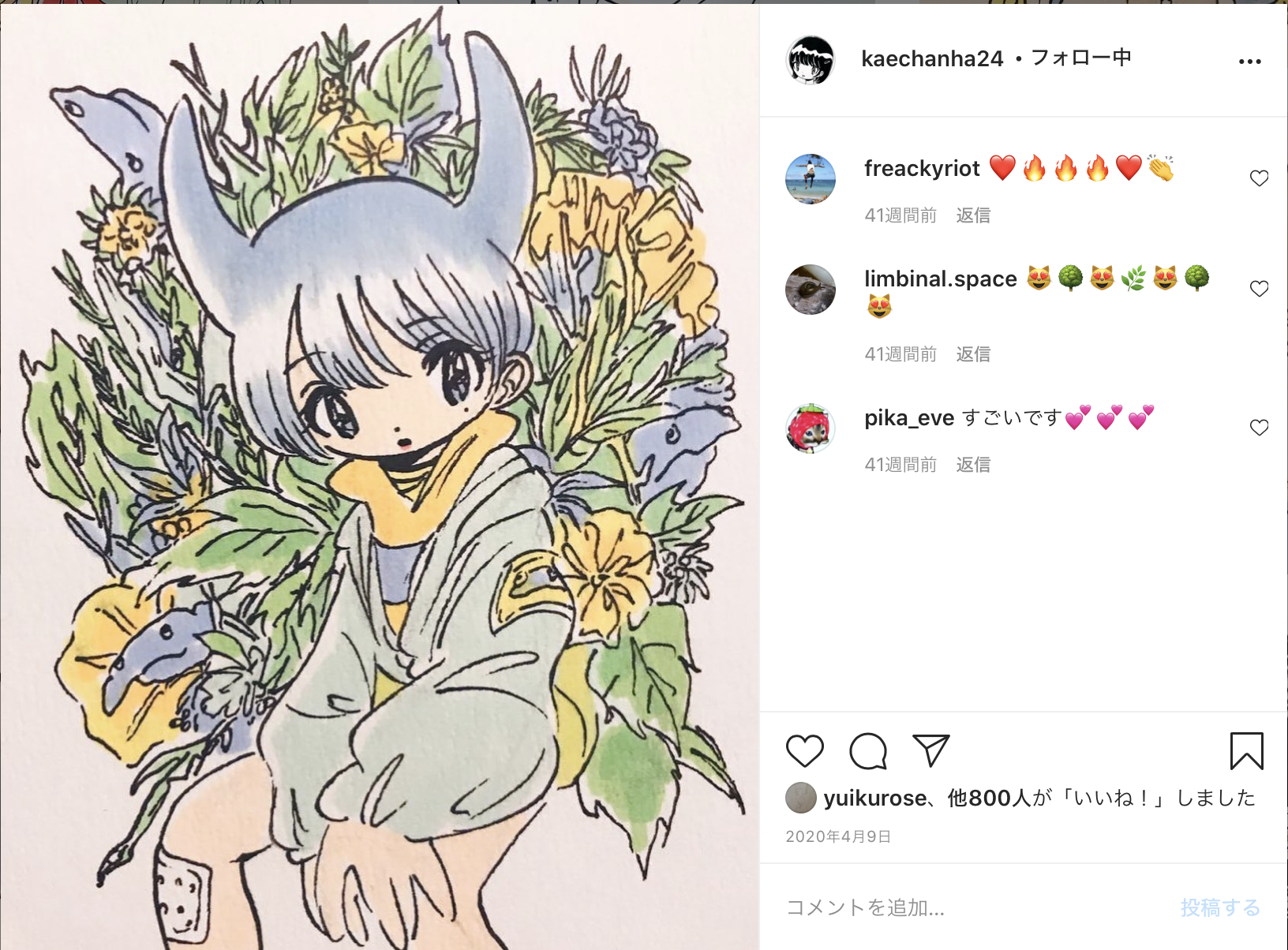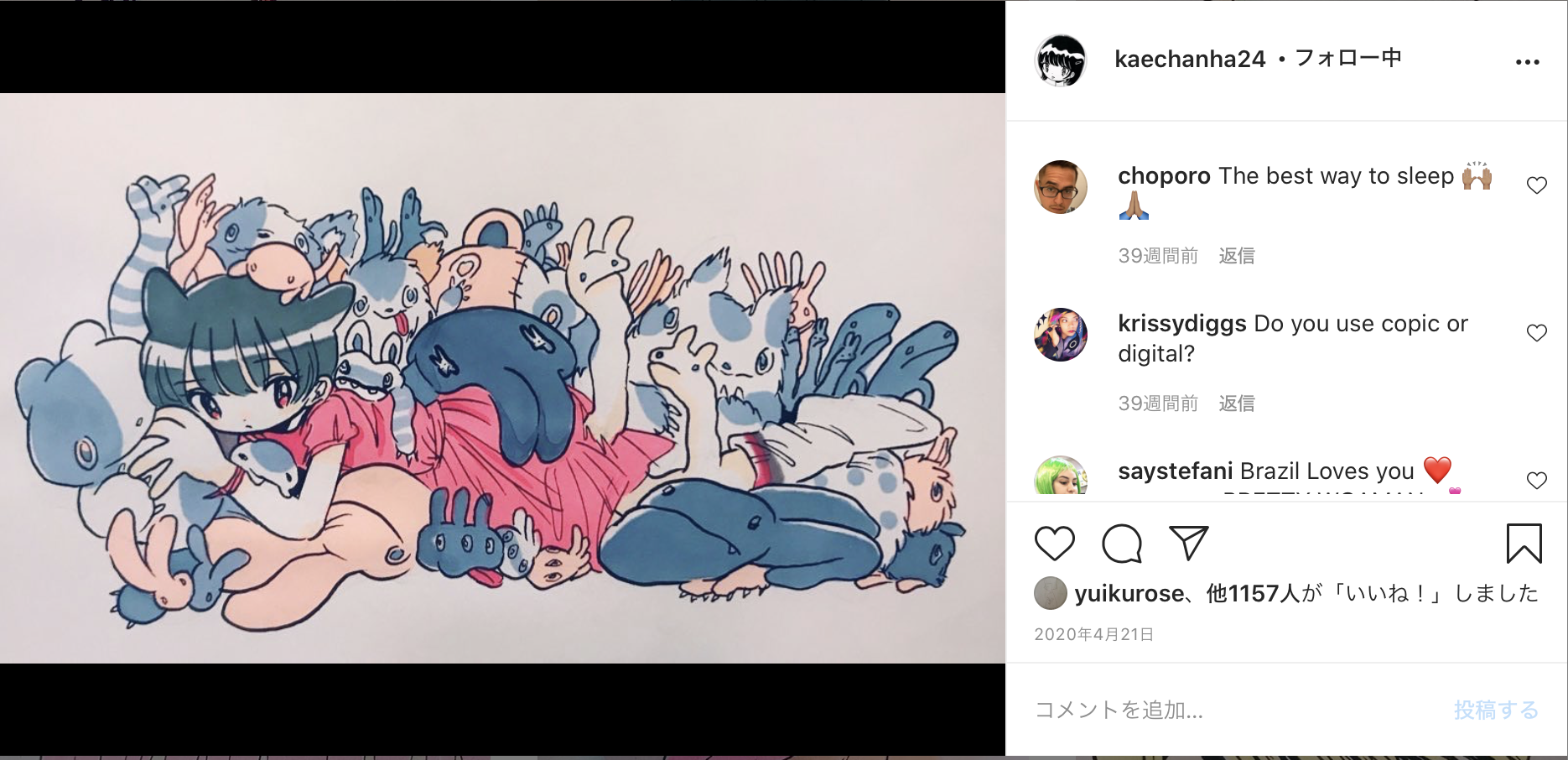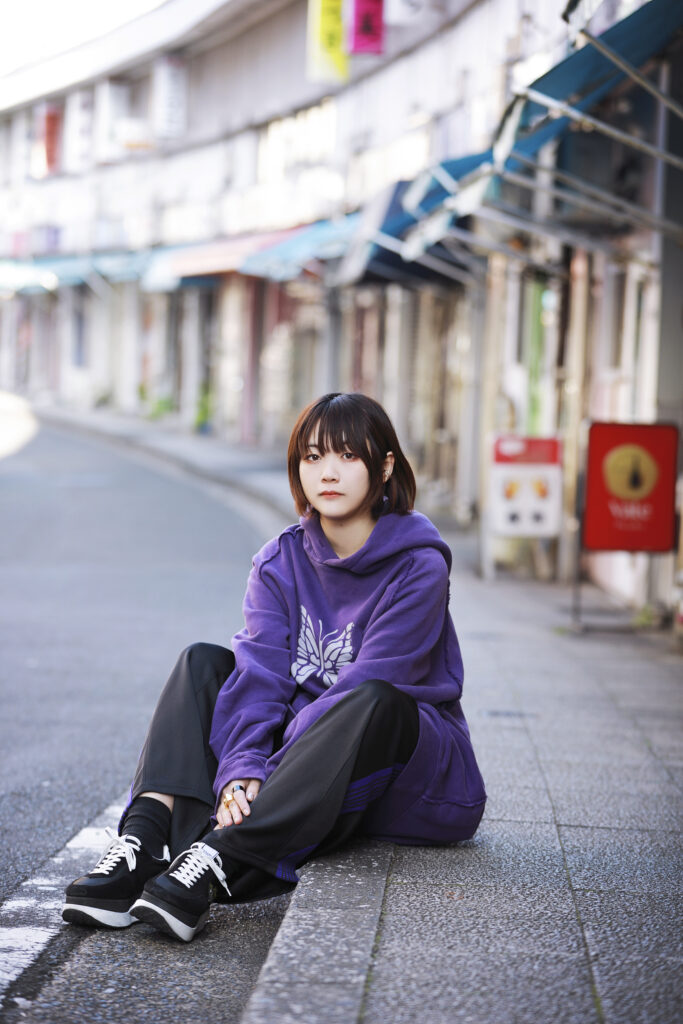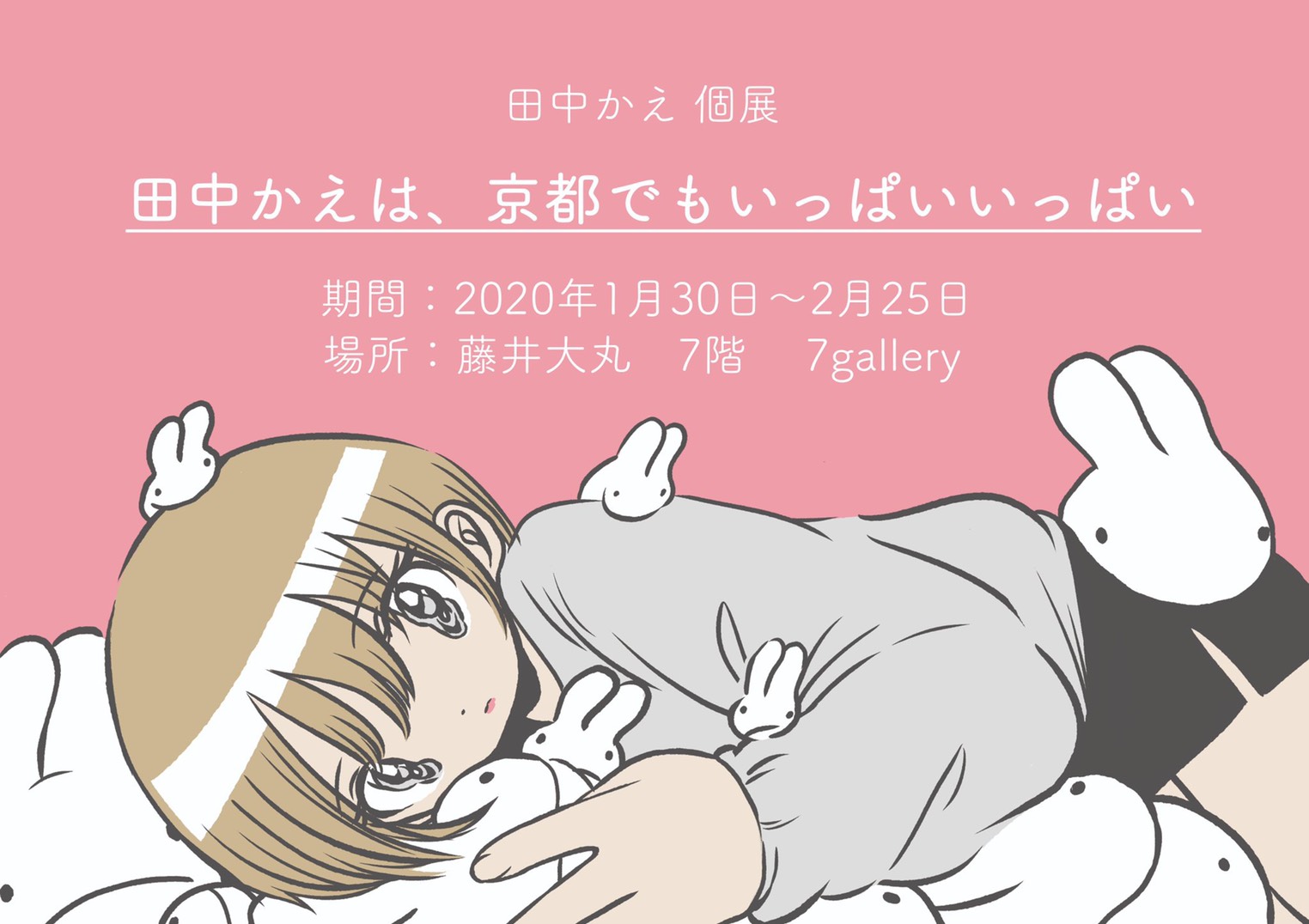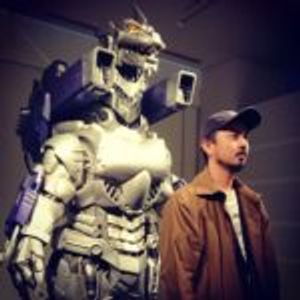Kae Tanaka is an artist gaining attention with her diverse collaborations with Nogizaka 46, Onitsuka Tiger, MEDICOM TOY, Beams and others. She claims to be inspired by Osamu Tezuka and Hideo Azuma, and portrays characters with unique traits of big eyes, elongated limbs, and soft forms. The human-like 2D “Kawaii” figures lure viewers into Tanaka’s distinctive worldview.
We sat down with the artist, who is opening her first solo exhibition in the Kansai region, Kae Tanaka-ha Kyoto-demo Ippai-Ippai, and spoke about the images of the girls she portrays, herself reflected in the background of her works, and eclectic details—such as makeup and fashion—of the characters.
With the expressive art form of drawing, “I may be able to put my thoughts out there”—Becoming an originator from a follower
――How did you begin drawing?
Kae Tanaka (Hereinafter Tanaka): My mother is a fan of Jun Miura and Hajime Anzai, and knows a lot about music—she was a subcultural person, who would introduce Klaus Nomi to my younger sister. Basically, I grew up in a family that understood art. Also, since I was little, my parents took me to art school. I was a girl who was “kind of good at drawing,” but when I entered middle school, people around me were quite impressed with my drawings—That’s when I started taking drawing seriously.
――So, you grew up with the basic background of art and subculture?
Tanaka: Yes, however, there was nothing like social media, where you could post and display your works to a wide audience, so, the only way to present my work was to draw on my friends’ personal belongings. Then, in high school, I started Twitter, and went to design festivals and COMITIA as a participant.
――So, you were inspired at these festivals and became an originator from a follower.
Tanaka: That’s right. I thought that I could put out my ideas through the expressive art form of drawing.
――You’ve been gaining attention through diverse collaborations. Where would you say was the starting point of your career?
Tanaka: I might be saying different things each time. [awkwardly laughs] My first work as an artist was—as far as I’m aware—for Nogizaka 46. I drew a picture on the music video script of their 18th single, “Nigemizu.” At that time, I was in my senior year of college, so it’s been three years already.
――What a sudden success!
Tanaka: It really is. I was so surprised when I got the offer, especially because the director of the music video was Seita Yamagishi, who also made music videos of my all-time favorite band, SAKEROCK.
――I’ve actually never heard of providing an artwork for a music video script.
Tanaka: I guess, it’s not a common thing? About the music video, it was the first time that the third-generation members, Momoko Ohzono and Yuki Yoda, were taking the center position, and the members and staff were extremely busy preparing for the shoot—I was told, “we want to cheer the members by putting cute illustrations in the script”—so, I drew the pictures for them.
――That was when you were still in college—how did you feel about this experience?
Tanaka: Even before that, I had been designing for the merch of indie idol groups, but it was different from that as there were a lot of back-and-forth communications and I had to wait to proceed until the client responded. It was a new and fun “real job” experience for me.
――You’ve also drawn an exclusive illustration for the book, Kimi ga Yume ni Dete Kita yo, written by Momoko Gumi Company from BiSH—There may be a lot of people noticing you through works you’ve done for the idol groups.
Tanaka: I think so, too. I’ve known Momoko for a while and I got the offer through my friend. There have been increasing cases of Seisoins (fans of BiSH) becoming interested in my works and visiting my pop-up events and exhibitions. They often approach me and introduce themselves, “I’m a Seisoin!” My first fan was also a Dempagumi.inc Otaku (nerd) who came to the co-exhibition I did with Munekyun (Mune Yumemi, ex-member of Dempagumi.inc.)
By discovering Osamu Tezuka and Hideo Azuma,
I gained confidence, thinking to myself “I’m fine the way I am”
――The girls you draw have “deforme” characteristics of huge eyes, long limbs, and soft forms. Tell me how you’ve developed this style.
Tanaka: My early drawings are quite insane now that I look at them. To begin with, I was ridiculously awful at sketching. I started going to a painting school in my senior year of high school and studied there only for a year; although it was a small class, I was always the worst. I was disappointed in myself and would cry listening to music on my way back home—It was so damn painful every day.
――I heard that getting into an art university is very tough.
Tanaka: That’s true. The entrance exams for art universities are all the same—they are consisted of still life drawing and color composition tests. It doesn’t make sense though, as the ambitions and objectives of the students are all different. For me, for example when sketching a still life object, I couldn’t understand the fundamental reason why the object had to be placed on a table. I didn’t know how to draw shadows, so if I drew a person, it would look like its floating. Simply, I was dumb. [awkwardly laughs]
――You’re probably good at drawing with your perceptions, rather than rendering realistic details.
Tanaka: That’s so true. In addition to the practical skills tests, I had to take Japanese literature and English exams, but luckily, these were the only subjects I did well on, so I barely passed as a backup candidate. For the important tests of still life drawing and color compositions, my score was only 50 out of 200. That’s almost the same as having no score—they must have given me the least for me to get in. [laughs] After I got accepted to Tama-bi (Tama art university), I took many classes and started realizing that being good at sketching is the key to be good at drawing illustrations. However, I still wasn’t good at sketching, so I had decided to practice by sketching an entire book of poses. I also sketched pictures in foreign art books that were in school, and gradually became capable of capturing various forms; then later, I started practicing still life sketching. As I was slowly honing my skills, I’ve struck upon manga.
――How were you impacted by manga?
Tanaka: I’ve noticed through Osamu Tezuka and Hideo Azuma’s works that there are “illustrations that don’t need to be realistic or accurate,” and felt sort of relieved when I discovered their works—I thought, “I’m fine just the way I am,” and gained confidence.
――Both artists are known for their drawings of cute girls—I can tell that you’re greatly inspired by them.
Tanaka: From Hideo Azuma’s works, I can really see that he enjoys drawing girls from their outlines. [laughs] The lines that make their forms are meticulously drawn. For me, it feels good to draw gender neutral characters like Astro Boy—with long eyelashes, hair, and adding multiple creases on clothes. When drawing, I particularly pay attention to the balance of facial features like eyes, nose and mouth. If you compare my past works, you will see the balance of these facial features are slightly different from one another, but I try to draw them consistently so that they share the same look. My current goal is to develop a distinctive drawing attribute that makes “Kae Tanaka’s pictures” distinguishable from others.
I wonder, what’s the point in emulating someone’s work?
――How do you get motivated to draw something?
Tanaka: I’m always keen to draw something. If I stop drawing, I get anxious that I would lose what I’ve built.
――Since you are constantly drawing, when comparing to your old works, I can see the girls are also evolving—maybe the balance of their heads and bodies are different from before.
Tanaka: That may be true. The way I color them hasn’t changed much, though. I think people would be able to tell from some of my works like, “this part is definitely influenced by Hideo Azuma.” There is that similar “femininity” of the characters.
――The cute outfits of the characters are also the highlight of your works. How do you come up with the ideas of their clothes?
Tanaka: Thank you. But they are mostly drawn naturally, and there aren’t that many variations. [laughs] They are mostly wearing sweaters or tops with oversized collars. Regarding the silhouette of the clothes, I like to make it voluminous or scrunched—it looks cuter that way.
――Not only from the manga you mentioned earlier and your fashion, but I can strongly feel your “favors” from your works.
Tanaka: I’m very particular with fashion and makeup. I used to draw characters in clothes that the girls from Nogizaka 46 would wear, because I liked that type of style; but nowadays, I often draw characters in streetwear clothes—they basically dress like me. [laughs]
――Regarding the characters’ makeup, in your early works, they seem to be wearing less makeup compared to the ones you draw now—the recent figures seem to be wearing a lot of eye-makeup.
Tanaka: I’ve always liked makeup in general; one day, I drew makeup on them out of curiosity and I liked it, so now I occasionally put makeup on them. I also like adding beauty spots on their faces. Like what I did with Momoko’s artwork, I try to portray every visible detail when I draw idol girls.
――It shows your particularity. By the way, I see a lot of artworks on social media that are presumably influenced by your works. How do you feel about them?
Tanaka: I do see some artworks that are drawn with the same style and structure as mine. These artists don’t follow me on socials, though. I don’t find their works interesting at all—I don’t even care about them anymore.
――They are hiding from you probably because they are aware that they are copying your works.
Tanaka: I guess so. I see illustrations of girls with distorted eyes, too, so I stopped drawing that type of eyes. I’m totally fine with people slightly imitating my style. In fact, I’m happy if someone tells me that he or she is inspired by my works. However, I merely think, what’s the point in emulating someone’s style?
――So, what is originality to you?
Tanaka: I think it’s defined by the outlines of the original drawings. There are lines that excite me like, “hell yeah!” and I instantly know that the drawing is going to be great. Sadly, it doesn’t happen that often. [awkwardly laughs] It’s usually when drawing the lines of facial features like eyes and nose. So, whenever I draw a nose, I hold my breath and concentrate.
――It’s all about the finishing touch.
Tanaka: The entire drawing could be affected by the tip of a pen. With this size of an illustration, it’s easy to draw a spec, but when it’s a bigger drawing, it gets really challenging to simply draw a dot. The ink thickness also varies depending on how fresh the pen is, so you need to gauge that part as well.
――There’s a saying, “a bad workman always blames his tools,” but perhaps, tools are important.
Tanaka: There are specific pens that are useful for drawing fine lines of hair. I try out different tools and change immediately if I don’t feel right with it. The past couple years, I’ve been loving the water-based pigment ink pen from Pilot called Juice Paint. I use 3B mechanical pencil when drafting. I’m heavy handed that the pencil lines tend to get thick and hard to remove, so I purposely choose a thick pencil and draw lightly in order to make lines visible but erasable.
――I can’t see the pencil lines at all—Do you draw without drafting?
Tanaka: Essentially, I hate the act of erasing. The paper would rip easily when rubbed with an eraser, and in that case, I would have to start from scratch again.
――You said you draw every day—when do you feel your improvement in drawing?
Tanaka: My drawings don’t look disastrous anymore with any type of art mediums. Also, since the time I provided the artwork for Beams, I don’t shy away from looking at my old works anymore. In that sense, I think I’ve grown as an artist.
“Kawaii” isn’t something that changes over time, but in fact, the variation gets wider through generations
――Currently, your solo exhibition, Kae Tanaka-ha Kyoto-demo Ippai-Ippai is opening. I heard it’s going to be your first exhibition in the Kansai region.
Tanaka: Yes! Other than my real artworks, I will be exhibiting my works in giclee (digital prints printed on the highest-grade material with the finest wide format color inkjet printer) and B0-size canvas. It’s my first time showing my works in giclee, so I’m slightly nervous to see people’s reactions on those, but I feel less hesitant as I’m getting used to my artworks made with digital technology.
――You will also be doing live caricature drawings on site.
Tanaka: It will only be for a very limited number of people, but yes, only on Saturdays and Sundays for those who register early. However, it’s not going to be a live drawing—we will be taking pictures of the people on site and ship the portraits later to their homes.
――That’s going to be fun. Tell me what you seek in your future.
Tanaka: I guess, I don’t want people to get bored of me. Nowadays, there are so many artworks that are only good enough on the internet. So, people buying my original artworks is such an honorable thing. Especially, when a young person tells me, “your artwork is the first art piece I’ve ever bought!”—it makes me feel like I’m on cloud nine. I would like for people to see the clothes and the figure toys that I’ve designed, but moreover, I want them to feel my real artworks. It may only take 30 or 40 minutes to draw one, but every work is imbued with what I’ve acquired and times I’ve spent with art.
――The Japanese Kawaii culture is popular all around the world. I can imagine you with your artworks getting great global responses and many offers.
Tanaka: Actually, 70% of my Instagram followers are from English-speaking countries. I’m interested in being active outside of Japan, but it could be challenging because it seems like people abroad prefer artworks in big sizes. Right now, I’m moving forward with the project of an Italian bag brand, doing my best with my poor English skill. I do get a lot of offers, but I have trouble trusting people and tend to ignore these emails. [laughs]
――The standard of “Kawaii” fluctuates through generations—Are the girls you draw going to be changing their styles in the future?
Tanaka: I don’t think “Kawaii” is something that changes over time, but instead, its variation gets wider through generations. If you look at the girls I’ve been drawing, there are some with drooping eyes and some with slanted eyes, and their hair styles and outfits are diverse. I think artists are better with wide range of expressions, and I strive to be that way.
――Finally, what are the qualities of the perfect girl you draw?
Tanaka: She must be the one with the perfect outline…I guess. Of course, if I were ever to draw one, I would never let go of her! [laughs]
Kae Tanaka
Born in 1995. An illustrator. Tanaka became influenced by Osamu Tezuka and Hideo Azuma, and began drawing. She started her artistic activities after graduating Tama Art University. She has been widely acclaimed for her multi-genre collaborations including Nogizaka 46, Momoko-gumi Company (from BiSH), Onitsuka Tiger, and Beams.
Twitter:@helloverysunday
Instagram:@kaechanha24
■Kae Tanaka-ha Kyoto-demo Ippai-Ippai
Date : 〜 February 25th
Venue : Kyoto Fujii Daimaru 7F 7gallery
Address : 605 Teianmae-cho, Shijosagaru, Teramachi-dori, Shimogyo-ku, Kyoto
Time : 10:30〜19:00
Closed : February 16th
https://www.fujiidaimaru.co.jp/limited_shop/2021-01-30tanakakae
Photography Shinpo Kimura
Translation Ai Kaneda

